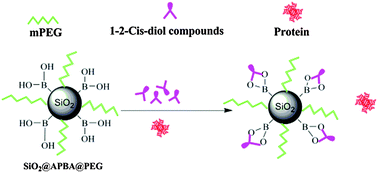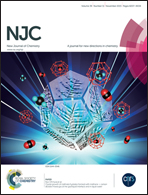One-pot preparation of boronic acid and PEG bi-functionalized silica particles for separation and purification of catecholamine from rat serum
Abstract
A facile one-pot preparation of aminophenylboronic acid (APBA) and poly(ethyleneglycol) (PEG) bi-functionalized silica particles named SiO2@APBA@PEG by the aid of epoxy silanes is described in this work. The as-prepared particles could not only selectively extract the catecholamine through boronate binding but could also effectively resist protein adsorption using PEG brushes; FT-IR spectra and contact angle measurements proved that APBA and PEG groups were successfully introduced into the surface of silica. The maximum adsorption capacities towards dopamine (DA) and levodopa (L-DOPA) were found to be 254.45 and 104.71 μmol g−1, respectively. The as-prepared material was used as a solid phase extraction (SPE) sorbent for the extraction of catecholamine from rat serum. The recoveries of DA and L-DOPA were 95 ± 3.21% and 93 ± 3.57%, meanwhile, proteins were eliminated. The obtained results indicated that the SiO2@APBA@PEG particles were qualified for efficient purification of catecholamine from complex biological samples.


 Please wait while we load your content...
Please wait while we load your content...